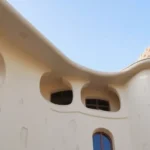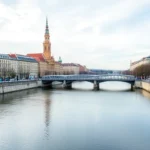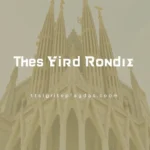13 interesting facts about the Sagrada Familia you might not know

- Did Gaudí really start the construction of the Sagrada Familia?
- The Sagrada Familia was built on empty land
- What happened after Gaudí's death?
- Reviving lost designs after the Spanish Civil War
- Curious models from real-life figures
- Nature as a guiding principle in design
- Stained glass windows of Vila-Grau
- Funding through donations alone
- The future tallest building in Barcelona
- A hidden sudoku in the Passion Facade
- Unique soundscape of the Sagrada Familia
- A strikingly realistic depiction of Christ
- Gaudí's visage in sculpture
The Sagrada Familia is not just a basilica; it is a living testament to the genius of Antoni Gaudí and his vision of architecture that transcends time. As one of the most iconic landmarks in the world, this architectural marvel holds countless secrets and stories waiting to be uncovered. If you're planning a visit or simply curious about its rich history, prepare to be amazed by these intriguing facts about the Sagrada Familia.
In this article, we delve deeper into the fascinating details, history, and unique features of this extraordinary temple. From its inception to its ongoing construction, discover what makes the Sagrada Familia a true masterpiece of modernism. Additionally, we'll share many interesting facts about la Sagrada Familia that will enhance your appreciation for this magnificent structure.
⭐ Here are all the tips for visiting the Sagrada Familia
Did Gaudí really start the construction of the Sagrada Familia?
Surprisingly, **Antoni Gaudí was not the original architect** of the Sagrada Familia. The first architect assigned to this ambitious project was Francisco de Paula del Villar, who began the work in 1882 on behalf of the bookshop owner and philanthropist Josep María Bocabella. However, due to differences in vision, Villar stepped down, and Gaudí took over, transforming the project into what we see today.
Gaudí’s radical redesign not only altered the basilica's architecture but also redefined Barcelona’s skyline. Without his influence, the city would lack one of its most emblematic symbols, forever altering its identity. These facts about the Sagrada Familia truly highlight the significance of Gaudí's contributions.
The Sagrada Familia was built on empty land
It’s astonishing to realize that the area where the Sagrada Familia stands today was once a desolate landscape. There were **no structures** or bustling neighborhoods; just an expansive **open field** away from the heart of Barcelona. The land was purchased for a mere **172,000 pesetas** (approximately €1,034), highlighting how much the city has evolved since the start of the construction.
Today, the Sagrada Familia is surrounded by a vibrant community, but its origins remind us of the ambitious vision that has transformed this once barren land into a magnificent site of cultural significance. These sagrada familia fun facts serve as a reminder of the transformation that took place over the years.
What happened after Gaudí's death?
Gaudí's life was tragically cut short when he was hit by a tram in 1926. At the time of his death, only the **Nativity Facade** had been completed. He meticulously documented every aspect of his design in detailed plans, which were followed by his successors. Unfortunately, the onset of the Spanish Civil War led to devastating losses.
During this tumultuous period, many of his original plans were destroyed in a fire, forcing architects to rely on a limited number of surviving models and sketches. This catastrophic event stalled construction until the 1950s, leaving the Sagrada Familia's future uncertain. These are just a few of the many fascinating sagrada familia interesting facts that illustrate the challenges faced during its construction.
Reviving lost designs after the Spanish Civil War
The aftermath of the Spanish Civil War was a setback for the Sagrada Familia. Many of Gaudí’s plans were lost, but some models and sketches survived. This limited recovery allowed the architects to **redesign the temple**, albeit with significant challenges. The reconstruction process took several decades and was fraught with difficulties as they tried to remain faithful to Gaudí's vision.
Curious models from real-life figures
In a time before advanced technology, Gaudí ingeniously used **real people as models** for the figures on the Nativity Facade. Neighbors, workers, and friends posed for sculptors to capture their likenesses. For instance, the figures in "The Escape to Egypt" depict community members, including the recognizable **mule named Margarita**.
Later, sculptor Etsuro Sotoo added diversity to the facade, incorporating **Asian features** into the sculptures, reflecting a modern and inclusive approach to Gaudí's original designs. These unique choices are just some of the many facts about la Sagrada Familia that highlight its artistic evolution.
Nature as a guiding principle in design
One of the most striking characteristics of the Sagrada Familia is its deep connection to **nature**. Gaudí believed that **curves represent divine creation**, while straight lines represent human intervention. As you step into the nave, the soaring columns resemble **trees in a forest**, creating an ethereal atmosphere enhanced by the colorful light filtering through the stained glass windows crafted by Joan Vila-Grau.
This organic design philosophy extends throughout the basilica, where various elements reflect the beauty of the natural world, including animals and plant motifs integrated into the stonework. It is these elements that contribute to the many sagrada familia fun facts that visitors can admire.
Stained glass windows of Vila-Grau
The stained glass windows are not just beautiful; they are **meticulously designed** to reflect the time of day. The **Nativity Facade** features cool-toned windows that embody the soft light of dawn, while the **Passion Facade** showcases warm hues representing the fiery colors of sunset. This clever use of color changes the **ambiance inside the basilica**, providing a unique experience depending on when you visit.
Funding through donations alone
One remarkable fact about the Sagrada Familia is that it is entirely funded by **private donations**. This means that every ticket purchased contributes directly to the construction. Interestingly, these tickets are exempt from VAT due to their charitable nature, which raises questions about taxation once the basilica is completed.
When you visit, you’re not just a spectator; you’re a part of this ongoing journey of creation. These insights are among the many intriguing facts about the Sagrada Familia that make it a unique cultural landmark.
The future tallest building in Barcelona
Once completed, the Sagrada Familia will claim the title of the **tallest building in Barcelona**, surpassing even the Torre Glòries and the Hotel Arts, reaching a height of **172.5 meters**. Gaudí intentionally designed the structure to be lower than Montjuïc, reinforcing his belief that human creations should never exceed the grandeur of nature.
Among the many enigmas of the Sagrada Familia, one particularly intriguing feature is the **4x4 meter numerical puzzle** on the Passion Facade. This design functions like a sudoku, where the sum of each row equals **33**, symbolizing the age of Christ at his death. This clever incorporation of numbers adds a layer of mystique to the already complex narrative of the basilica.
Unique soundscape of the Sagrada Familia
Every hour, the Sagrada Familia fills the air with a **distinct melody**, marking the time in a beautiful way. Starting at 9:00 AM, the first tune is “Sol solet,” a beloved children's song in Catalonia. Different melodies are played throughout the day, with the 12:00 and 20:00 performances being particularly enchanting.
A strikingly realistic depiction of Christ
The **main altar** is designed with simplicity in mind, featuring a bold baldaquin suspended above it. The centerpiece is a sculpture of Christ on the cross that deviates from traditional representations; he is depicted in a **realistic posture**, with his legs bent to reflect the natural response of a body succumbing to asphyxiation. This attention to realism is one of the hallmarks of Gaudí's approach to art and architecture.
Gaudí's visage in sculpture
In a fascinating twist, **one of the sculptures in the Passion Facade** features the likeness of Antoni Gaudí himself. In “La Verónica,” a faceless woman holds the **Holy Shroud**, while to her right stands one of the evangelists modeled after Gaudí. Additionally, the helmets of the Roman soldiers are crafted to resemble the chimneys of **La Pedrera**, paying homage to another of Gaudí's masterpieces.
We would like to extend our gratitude to Visit Barcelona for inviting us to explore this marvel of Gaudí. Follow them on social media for more insights into the wonders of this vibrant city.
These are just a few of the **fascinating curiosities of the Sagrada Familia**, but there is so much more to discover. If you're eager to learn about all its secrets, consider joining a comprehensive guided tour that takes you through various sections of the Sagrada Familia.
Prepare to be astonished and inspired by the beauty and complexity of Barcelona's most iconic symbol!
Looking for the best travel deals? Here are some tips:




Deja una respuesta